System Analysis Report: Headspace Project for Mental Health Foundation
VerifiedAdded on 2019/11/08
|10
|1671
|364
Report
AI Summary
This report presents a system analysis of a healthcare project focused on the National Youth Mental Health Foundation's 'Headspace' initiative, aimed at improving mental health services for youth aged 12-25. The analysis begins with an introduction to the project, followed by stakeholder identification and mapping, detailing their interests, and including a four-quadrant stakeholder map. A questionnaire designed for patients, a key stakeholder group, is provided, alongside an explanation of its purpose. The report then presents a use case diagram illustrating the interactions within the system, along with detailed use case descriptions. The Australian government's allocation of $54 billion for the project is highlighted. The report concludes by summarizing the key components of the project and its analysis, emphasizing the importance of stakeholder engagement and system design in achieving the project's goals.
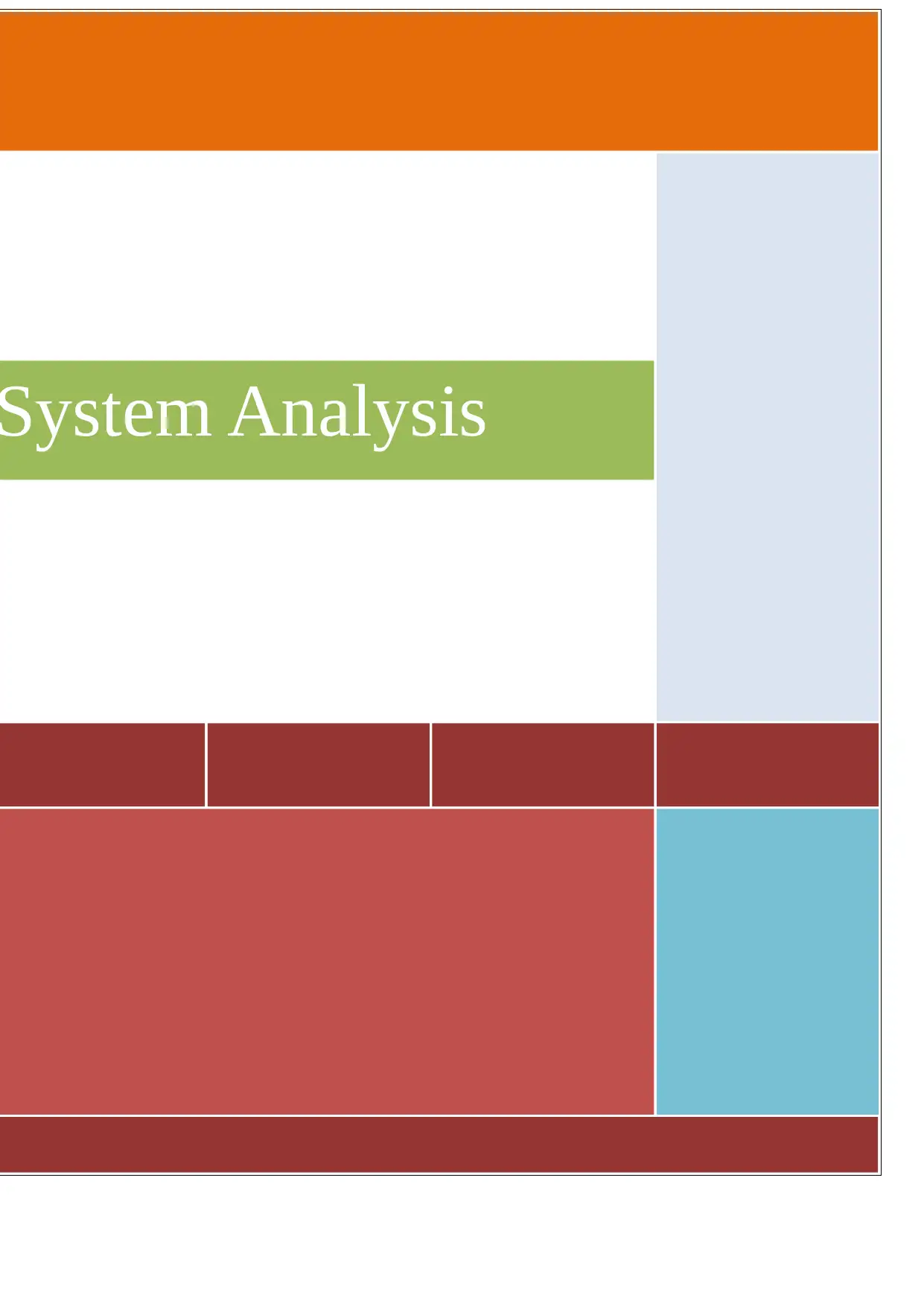
System Analysis
Paraphrase This Document
Need a fresh take? Get an instant paraphrase of this document with our AI Paraphraser
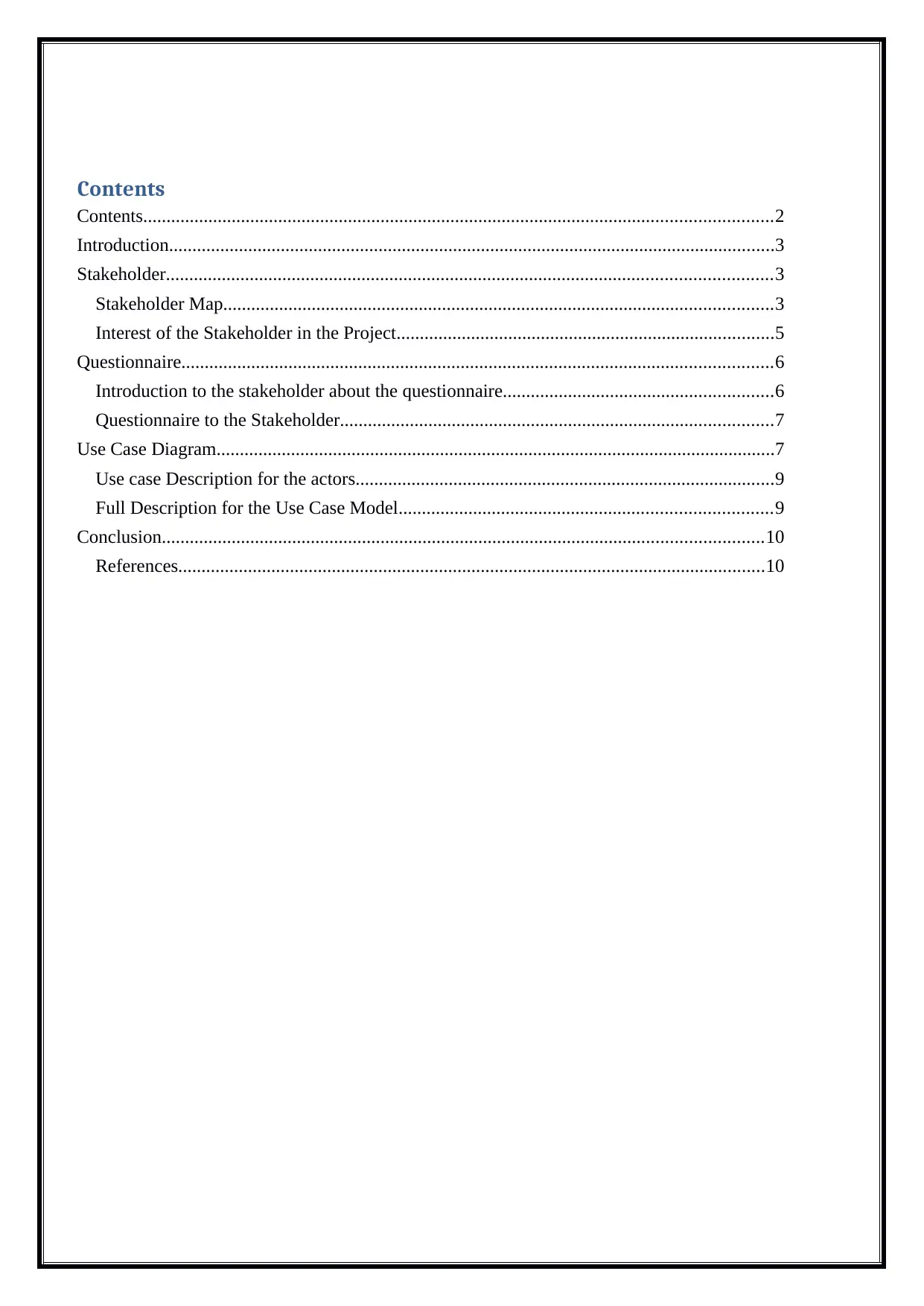
Contents
Contents.......................................................................................................................................2
Introduction..................................................................................................................................3
Stakeholder..................................................................................................................................3
Stakeholder Map......................................................................................................................3
Interest of the Stakeholder in the Project.................................................................................5
Questionnaire...............................................................................................................................6
Introduction to the stakeholder about the questionnaire..........................................................6
Questionnaire to the Stakeholder.............................................................................................7
Use Case Diagram........................................................................................................................7
Use case Description for the actors..........................................................................................9
Full Description for the Use Case Model................................................................................9
Conclusion.................................................................................................................................10
References..............................................................................................................................10
Contents.......................................................................................................................................2
Introduction..................................................................................................................................3
Stakeholder..................................................................................................................................3
Stakeholder Map......................................................................................................................3
Interest of the Stakeholder in the Project.................................................................................5
Questionnaire...............................................................................................................................6
Introduction to the stakeholder about the questionnaire..........................................................6
Questionnaire to the Stakeholder.............................................................................................7
Use Case Diagram........................................................................................................................7
Use case Description for the actors..........................................................................................9
Full Description for the Use Case Model................................................................................9
Conclusion.................................................................................................................................10
References..............................................................................................................................10
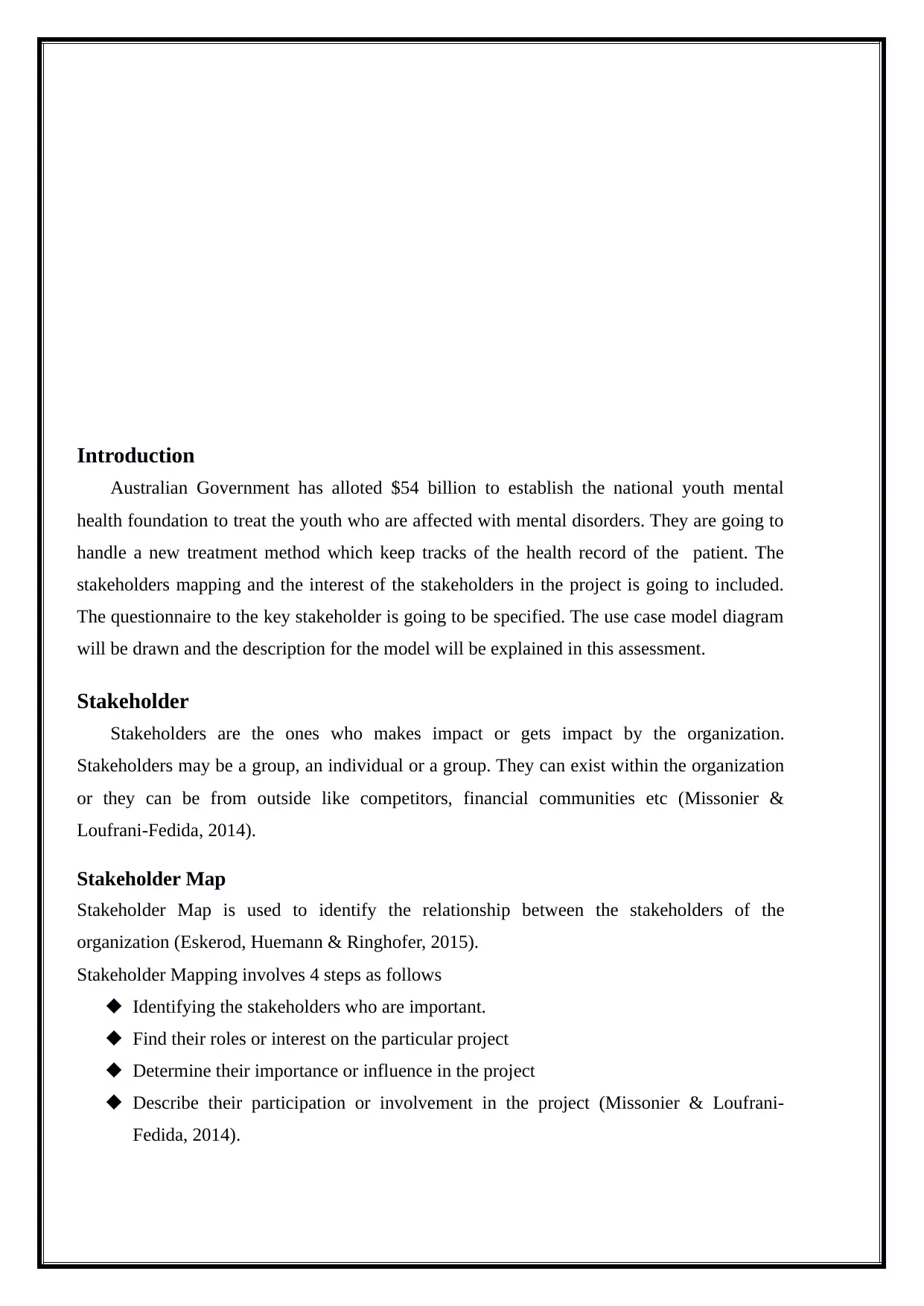
Introduction
Australian Government has alloted $54 billion to establish the national youth mental
health foundation to treat the youth who are affected with mental disorders. They are going to
handle a new treatment method which keep tracks of the health record of the patient. The
stakeholders mapping and the interest of the stakeholders in the project is going to included.
The questionnaire to the key stakeholder is going to be specified. The use case model diagram
will be drawn and the description for the model will be explained in this assessment.
Stakeholder
Stakeholders are the ones who makes impact or gets impact by the organization.
Stakeholders may be a group, an individual or a group. They can exist within the organization
or they can be from outside like competitors, financial communities etc (Missonier &
Loufrani-Fedida, 2014).
Stakeholder Map
Stakeholder Map is used to identify the relationship between the stakeholders of the
organization (Eskerod, Huemann & Ringhofer, 2015).
Stakeholder Mapping involves 4 steps as follows
Identifying the stakeholders who are important.
Find their roles or interest on the particular project
Determine their importance or influence in the project
Describe their participation or involvement in the project (Missonier & Loufrani-
Fedida, 2014).
Australian Government has alloted $54 billion to establish the national youth mental
health foundation to treat the youth who are affected with mental disorders. They are going to
handle a new treatment method which keep tracks of the health record of the patient. The
stakeholders mapping and the interest of the stakeholders in the project is going to included.
The questionnaire to the key stakeholder is going to be specified. The use case model diagram
will be drawn and the description for the model will be explained in this assessment.
Stakeholder
Stakeholders are the ones who makes impact or gets impact by the organization.
Stakeholders may be a group, an individual or a group. They can exist within the organization
or they can be from outside like competitors, financial communities etc (Missonier &
Loufrani-Fedida, 2014).
Stakeholder Map
Stakeholder Map is used to identify the relationship between the stakeholders of the
organization (Eskerod, Huemann & Ringhofer, 2015).
Stakeholder Mapping involves 4 steps as follows
Identifying the stakeholders who are important.
Find their roles or interest on the particular project
Determine their importance or influence in the project
Describe their participation or involvement in the project (Missonier & Loufrani-
Fedida, 2014).
⊘ This is a preview!⊘
Do you want full access?
Subscribe today to unlock all pages.

Trusted by 1+ million students worldwide
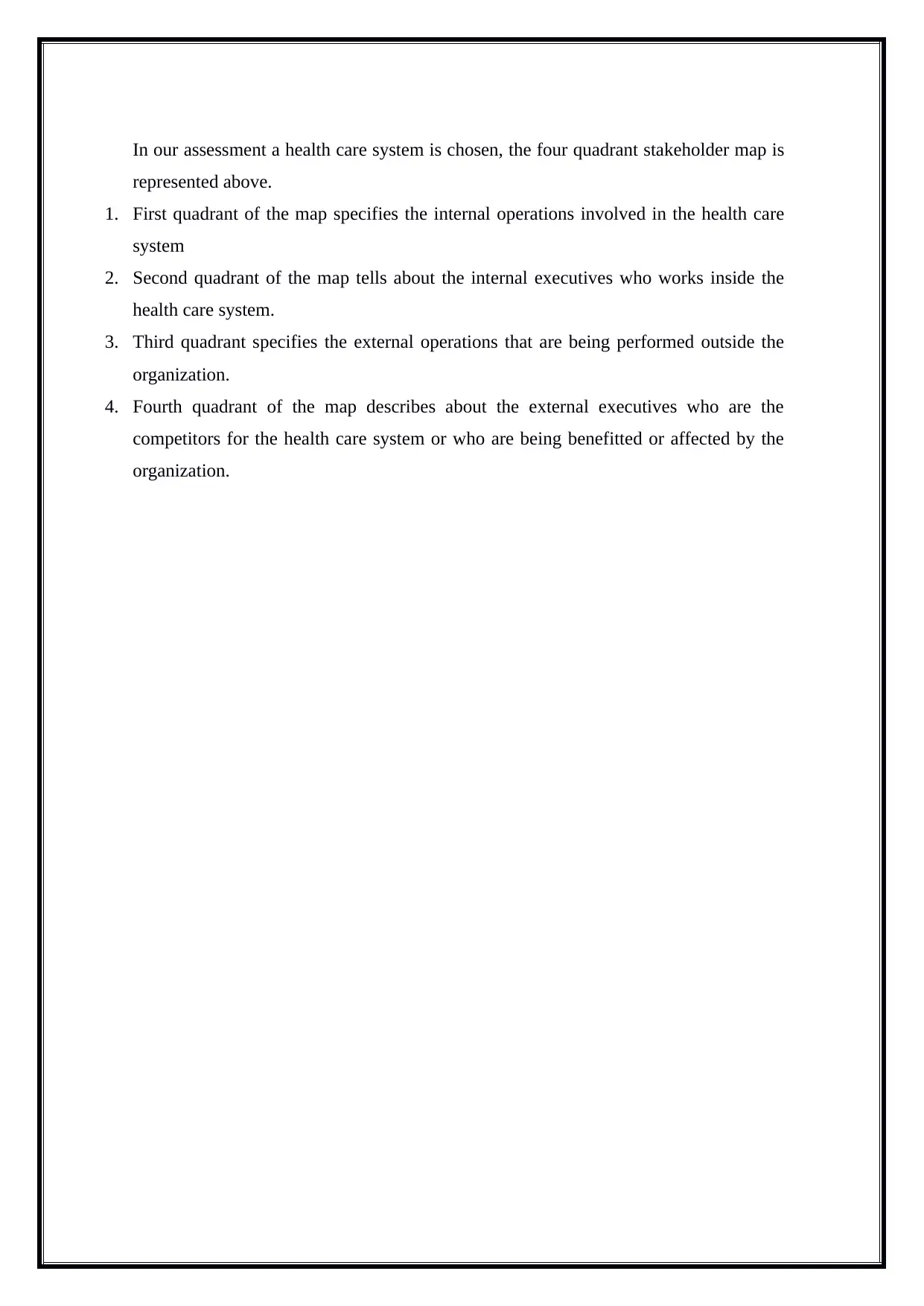
In our assessment a health care system is chosen, the four quadrant stakeholder map is
represented above.
1. First quadrant of the map specifies the internal operations involved in the health care
system
2. Second quadrant of the map tells about the internal executives who works inside the
health care system.
3. Third quadrant specifies the external operations that are being performed outside the
organization.
4. Fourth quadrant of the map describes about the external executives who are the
competitors for the health care system or who are being benefitted or affected by the
organization.
represented above.
1. First quadrant of the map specifies the internal operations involved in the health care
system
2. Second quadrant of the map tells about the internal executives who works inside the
health care system.
3. Third quadrant specifies the external operations that are being performed outside the
organization.
4. Fourth quadrant of the map describes about the external executives who are the
competitors for the health care system or who are being benefitted or affected by the
organization.
Paraphrase This Document
Need a fresh take? Get an instant paraphrase of this document with our AI Paraphraser
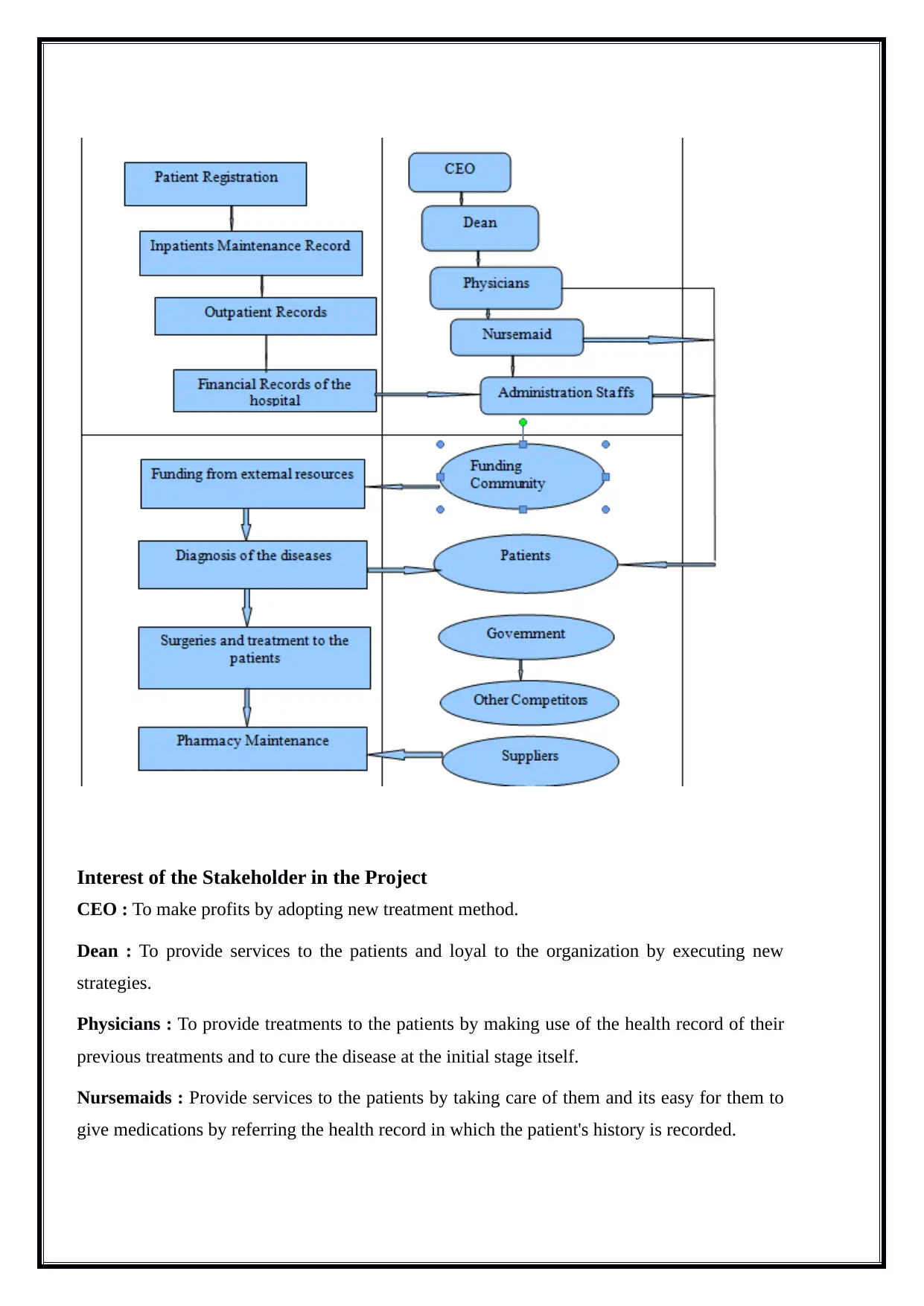
Interest of the Stakeholder in the Project
CEO : To make profits by adopting new treatment method.
Dean : To provide services to the patients and loyal to the organization by executing new
strategies.
Physicians : To provide treatments to the patients by making use of the health record of their
previous treatments and to cure the disease at the initial stage itself.
Nursemaids : Provide services to the patients by taking care of them and its easy for them to
give medications by referring the health record in which the patient's history is recorded.
CEO : To make profits by adopting new treatment method.
Dean : To provide services to the patients and loyal to the organization by executing new
strategies.
Physicians : To provide treatments to the patients by making use of the health record of their
previous treatments and to cure the disease at the initial stage itself.
Nursemaids : Provide services to the patients by taking care of them and its easy for them to
give medications by referring the health record in which the patient's history is recorded.
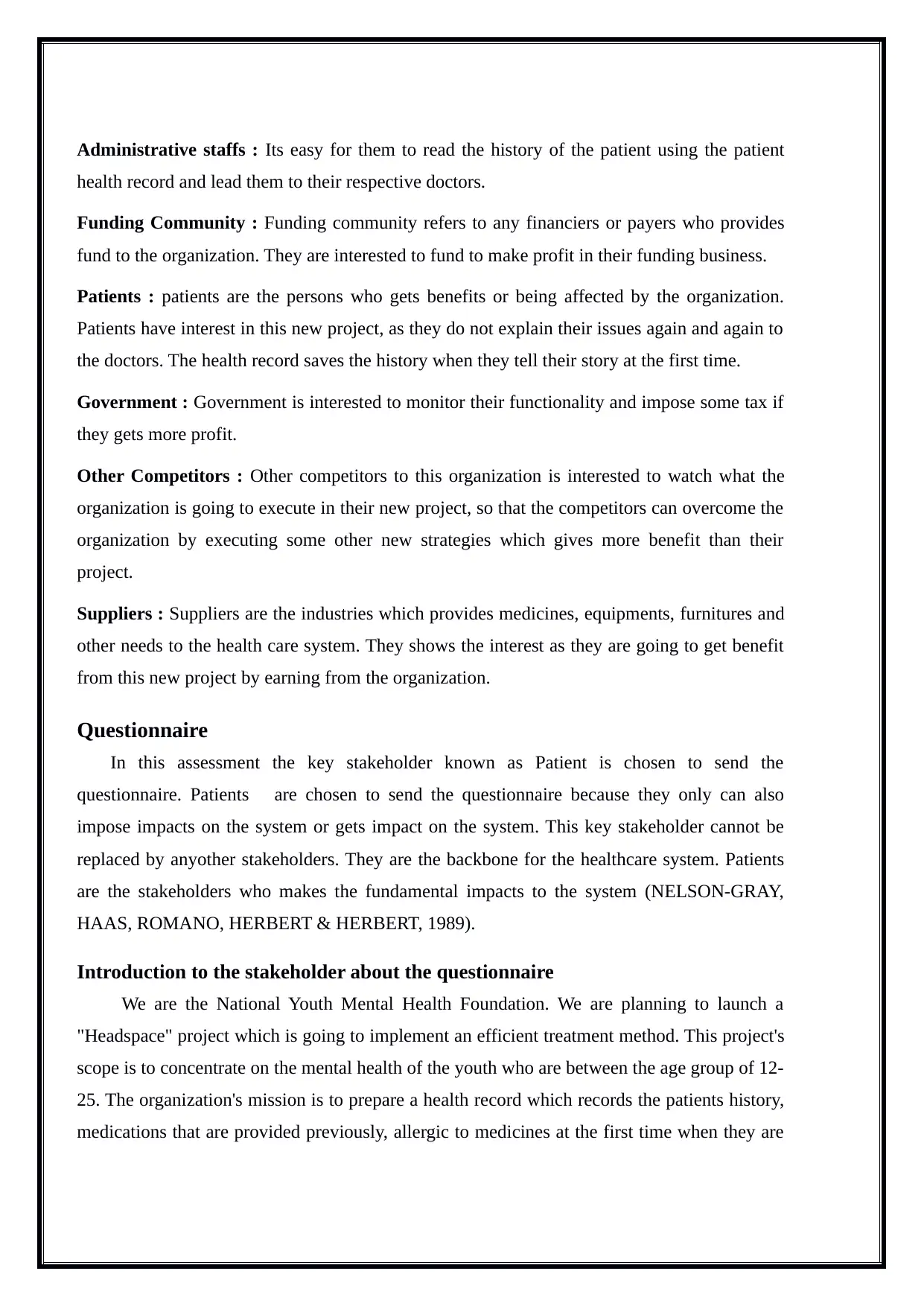
Administrative staffs : Its easy for them to read the history of the patient using the patient
health record and lead them to their respective doctors.
Funding Community : Funding community refers to any financiers or payers who provides
fund to the organization. They are interested to fund to make profit in their funding business.
Patients : patients are the persons who gets benefits or being affected by the organization.
Patients have interest in this new project, as they do not explain their issues again and again to
the doctors. The health record saves the history when they tell their story at the first time.
Government : Government is interested to monitor their functionality and impose some tax if
they gets more profit.
Other Competitors : Other competitors to this organization is interested to watch what the
organization is going to execute in their new project, so that the competitors can overcome the
organization by executing some other new strategies which gives more benefit than their
project.
Suppliers : Suppliers are the industries which provides medicines, equipments, furnitures and
other needs to the health care system. They shows the interest as they are going to get benefit
from this new project by earning from the organization.
Questionnaire
In this assessment the key stakeholder known as Patient is chosen to send the
questionnaire. Patients are chosen to send the questionnaire because they only can also
impose impacts on the system or gets impact on the system. This key stakeholder cannot be
replaced by anyother stakeholders. They are the backbone for the healthcare system. Patients
are the stakeholders who makes the fundamental impacts to the system (NELSON-GRAY,
HAAS, ROMANO, HERBERT & HERBERT, 1989).
Introduction to the stakeholder about the questionnaire
We are the National Youth Mental Health Foundation. We are planning to launch a
"Headspace" project which is going to implement an efficient treatment method. This project's
scope is to concentrate on the mental health of the youth who are between the age group of 12-
25. The organization's mission is to prepare a health record which records the patients history,
medications that are provided previously, allergic to medicines at the first time when they are
health record and lead them to their respective doctors.
Funding Community : Funding community refers to any financiers or payers who provides
fund to the organization. They are interested to fund to make profit in their funding business.
Patients : patients are the persons who gets benefits or being affected by the organization.
Patients have interest in this new project, as they do not explain their issues again and again to
the doctors. The health record saves the history when they tell their story at the first time.
Government : Government is interested to monitor their functionality and impose some tax if
they gets more profit.
Other Competitors : Other competitors to this organization is interested to watch what the
organization is going to execute in their new project, so that the competitors can overcome the
organization by executing some other new strategies which gives more benefit than their
project.
Suppliers : Suppliers are the industries which provides medicines, equipments, furnitures and
other needs to the health care system. They shows the interest as they are going to get benefit
from this new project by earning from the organization.
Questionnaire
In this assessment the key stakeholder known as Patient is chosen to send the
questionnaire. Patients are chosen to send the questionnaire because they only can also
impose impacts on the system or gets impact on the system. This key stakeholder cannot be
replaced by anyother stakeholders. They are the backbone for the healthcare system. Patients
are the stakeholders who makes the fundamental impacts to the system (NELSON-GRAY,
HAAS, ROMANO, HERBERT & HERBERT, 1989).
Introduction to the stakeholder about the questionnaire
We are the National Youth Mental Health Foundation. We are planning to launch a
"Headspace" project which is going to implement an efficient treatment method. This project's
scope is to concentrate on the mental health of the youth who are between the age group of 12-
25. The organization's mission is to prepare a health record which records the patients history,
medications that are provided previously, allergic to medicines at the first time when they are
⊘ This is a preview!⊘
Do you want full access?
Subscribe today to unlock all pages.

Trusted by 1+ million students worldwide
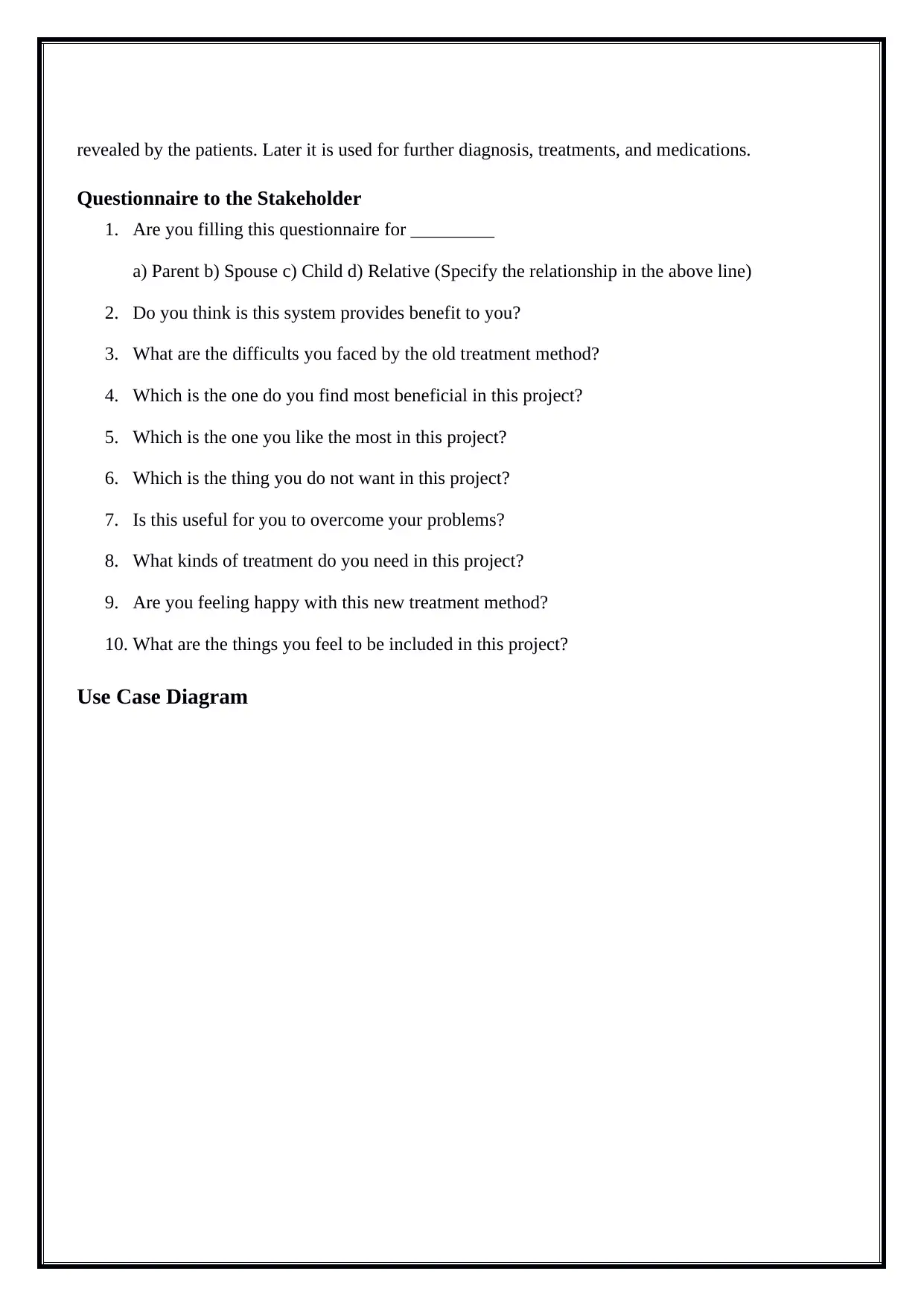
revealed by the patients. Later it is used for further diagnosis, treatments, and medications.
Questionnaire to the Stakeholder
1. Are you filling this questionnaire for _________
a) Parent b) Spouse c) Child d) Relative (Specify the relationship in the above line)
2. Do you think is this system provides benefit to you?
3. What are the difficults you faced by the old treatment method?
4. Which is the one do you find most beneficial in this project?
5. Which is the one you like the most in this project?
6. Which is the thing you do not want in this project?
7. Is this useful for you to overcome your problems?
8. What kinds of treatment do you need in this project?
9. Are you feeling happy with this new treatment method?
10. What are the things you feel to be included in this project?
Use Case Diagram
Questionnaire to the Stakeholder
1. Are you filling this questionnaire for _________
a) Parent b) Spouse c) Child d) Relative (Specify the relationship in the above line)
2. Do you think is this system provides benefit to you?
3. What are the difficults you faced by the old treatment method?
4. Which is the one do you find most beneficial in this project?
5. Which is the one you like the most in this project?
6. Which is the thing you do not want in this project?
7. Is this useful for you to overcome your problems?
8. What kinds of treatment do you need in this project?
9. Are you feeling happy with this new treatment method?
10. What are the things you feel to be included in this project?
Use Case Diagram
Paraphrase This Document
Need a fresh take? Get an instant paraphrase of this document with our AI Paraphraser
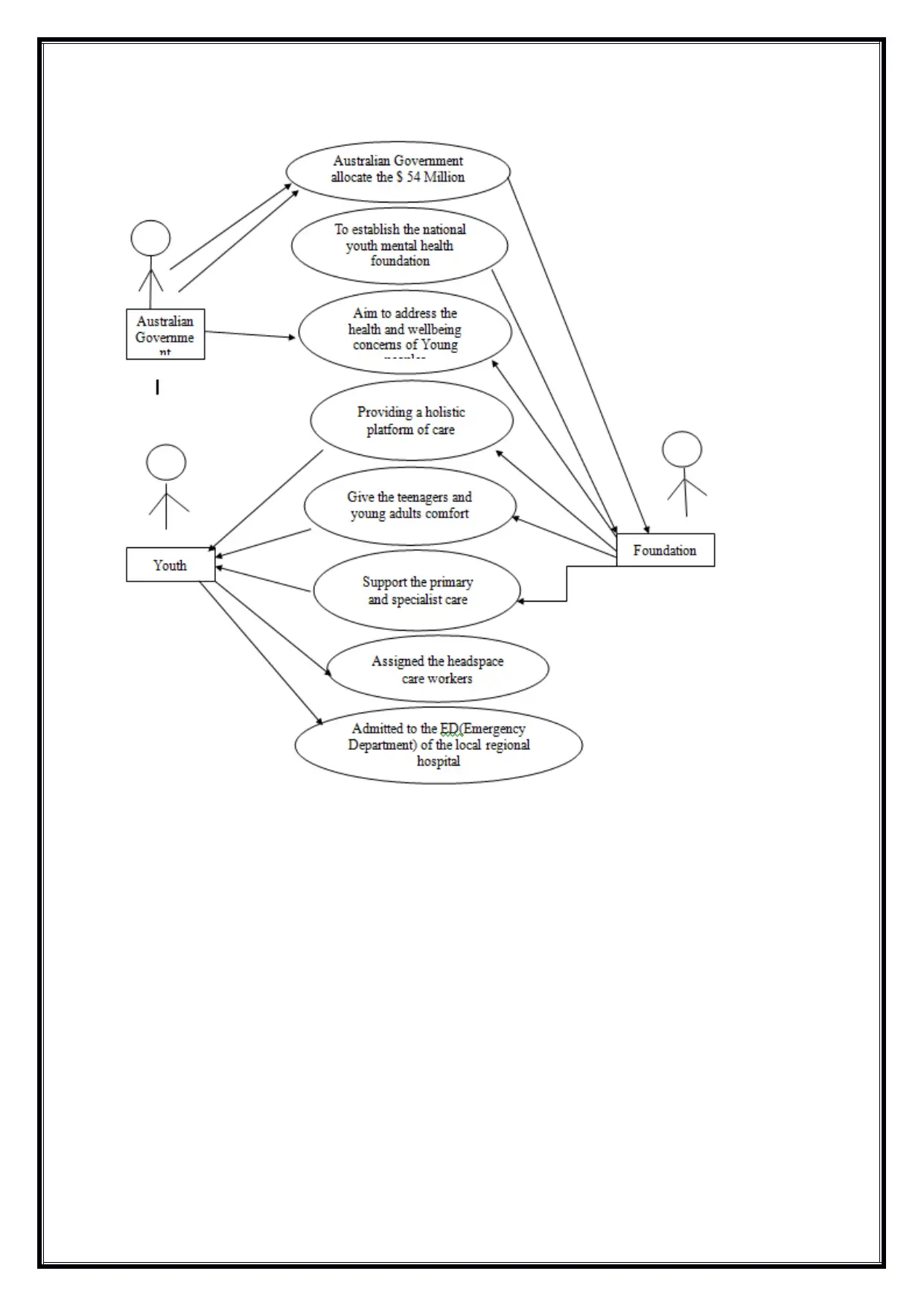
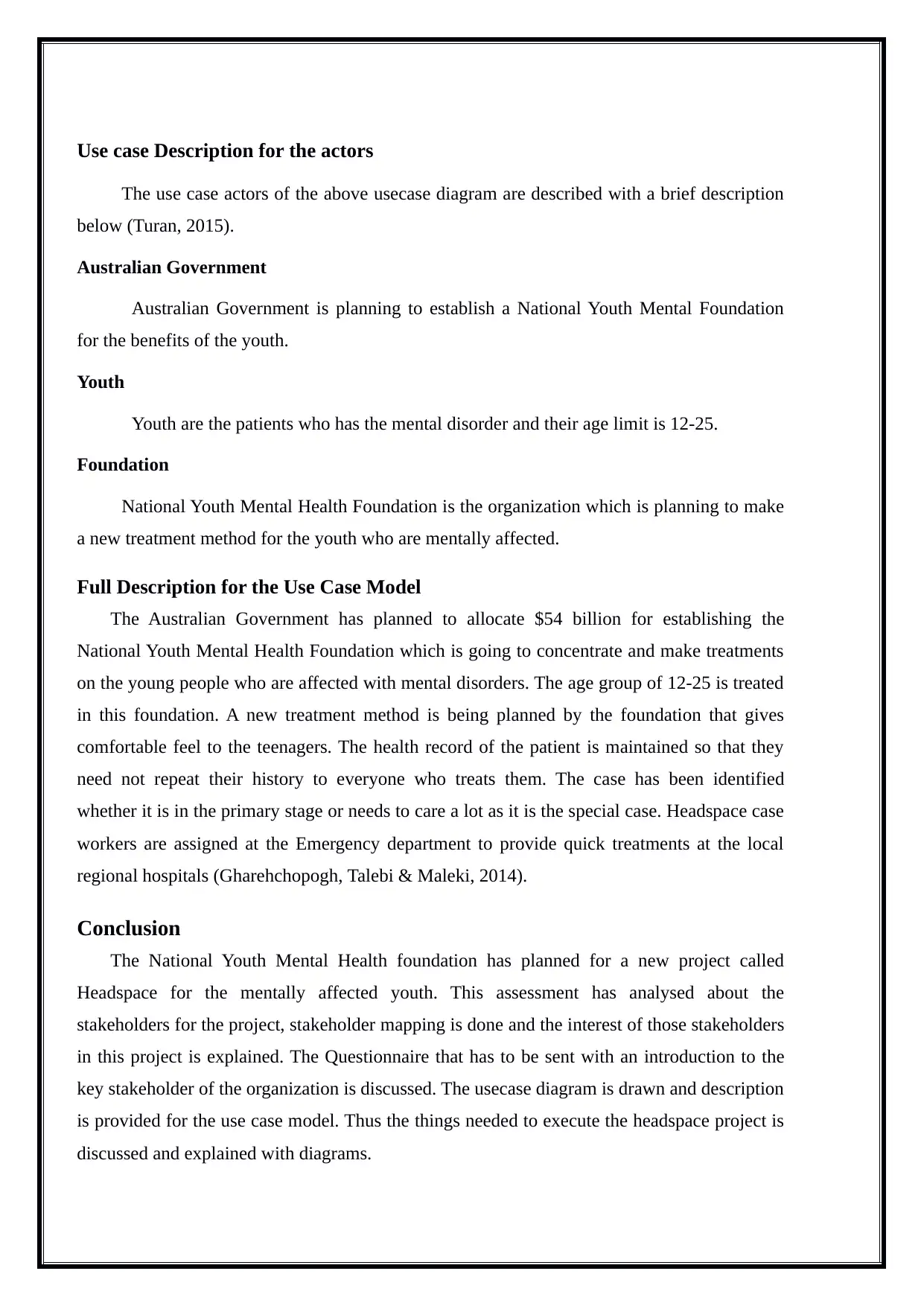
Use case Description for the actors
The use case actors of the above usecase diagram are described with a brief description
below (Turan, 2015).
Australian Government
Australian Government is planning to establish a National Youth Mental Foundation
for the benefits of the youth.
Youth
Youth are the patients who has the mental disorder and their age limit is 12-25.
Foundation
National Youth Mental Health Foundation is the organization which is planning to make
a new treatment method for the youth who are mentally affected.
Full Description for the Use Case Model
The Australian Government has planned to allocate $54 billion for establishing the
National Youth Mental Health Foundation which is going to concentrate and make treatments
on the young people who are affected with mental disorders. The age group of 12-25 is treated
in this foundation. A new treatment method is being planned by the foundation that gives
comfortable feel to the teenagers. The health record of the patient is maintained so that they
need not repeat their history to everyone who treats them. The case has been identified
whether it is in the primary stage or needs to care a lot as it is the special case. Headspace case
workers are assigned at the Emergency department to provide quick treatments at the local
regional hospitals (Gharehchopogh, Talebi & Maleki, 2014).
Conclusion
The National Youth Mental Health foundation has planned for a new project called
Headspace for the mentally affected youth. This assessment has analysed about the
stakeholders for the project, stakeholder mapping is done and the interest of those stakeholders
in this project is explained. The Questionnaire that has to be sent with an introduction to the
key stakeholder of the organization is discussed. The usecase diagram is drawn and description
is provided for the use case model. Thus the things needed to execute the headspace project is
discussed and explained with diagrams.
The use case actors of the above usecase diagram are described with a brief description
below (Turan, 2015).
Australian Government
Australian Government is planning to establish a National Youth Mental Foundation
for the benefits of the youth.
Youth
Youth are the patients who has the mental disorder and their age limit is 12-25.
Foundation
National Youth Mental Health Foundation is the organization which is planning to make
a new treatment method for the youth who are mentally affected.
Full Description for the Use Case Model
The Australian Government has planned to allocate $54 billion for establishing the
National Youth Mental Health Foundation which is going to concentrate and make treatments
on the young people who are affected with mental disorders. The age group of 12-25 is treated
in this foundation. A new treatment method is being planned by the foundation that gives
comfortable feel to the teenagers. The health record of the patient is maintained so that they
need not repeat their history to everyone who treats them. The case has been identified
whether it is in the primary stage or needs to care a lot as it is the special case. Headspace case
workers are assigned at the Emergency department to provide quick treatments at the local
regional hospitals (Gharehchopogh, Talebi & Maleki, 2014).
Conclusion
The National Youth Mental Health foundation has planned for a new project called
Headspace for the mentally affected youth. This assessment has analysed about the
stakeholders for the project, stakeholder mapping is done and the interest of those stakeholders
in this project is explained. The Questionnaire that has to be sent with an introduction to the
key stakeholder of the organization is discussed. The usecase diagram is drawn and description
is provided for the use case model. Thus the things needed to execute the headspace project is
discussed and explained with diagrams.
⊘ This is a preview!⊘
Do you want full access?
Subscribe today to unlock all pages.

Trusted by 1+ million students worldwide
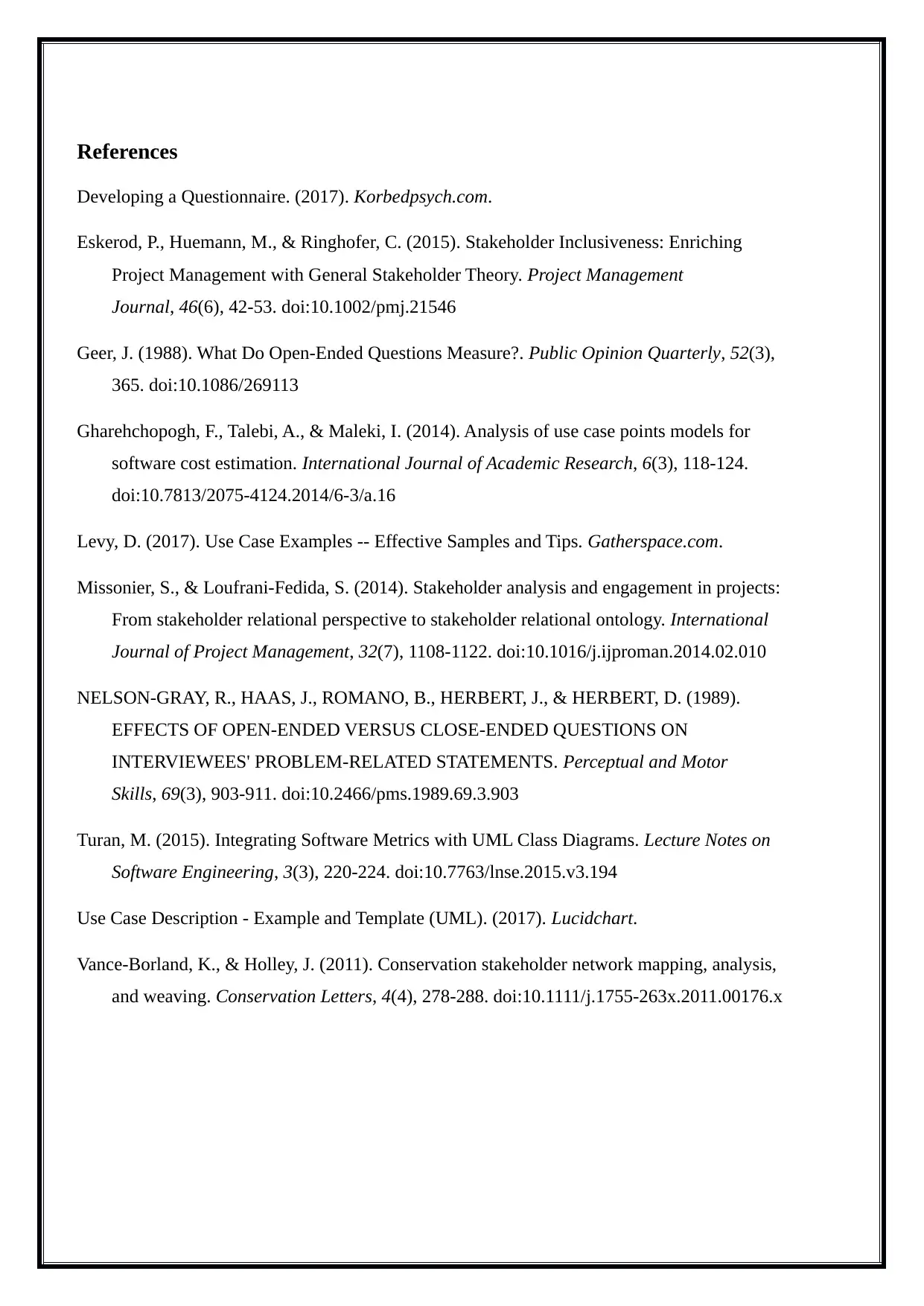
References
Developing a Questionnaire. (2017). Korbedpsych.com.
Eskerod, P., Huemann, M., & Ringhofer, C. (2015). Stakeholder Inclusiveness: Enriching
Project Management with General Stakeholder Theory. Project Management
Journal, 46(6), 42-53. doi:10.1002/pmj.21546
Geer, J. (1988). What Do Open-Ended Questions Measure?. Public Opinion Quarterly, 52(3),
365. doi:10.1086/269113
Gharehchopogh, F., Talebi, A., & Maleki, I. (2014). Analysis of use case points models for
software cost estimation. International Journal of Academic Research, 6(3), 118-124.
doi:10.7813/2075-4124.2014/6-3/a.16
Levy, D. (2017). Use Case Examples -- Effective Samples and Tips. Gatherspace.com.
Missonier, S., & Loufrani-Fedida, S. (2014). Stakeholder analysis and engagement in projects:
From stakeholder relational perspective to stakeholder relational ontology. International
Journal of Project Management, 32(7), 1108-1122. doi:10.1016/j.ijproman.2014.02.010
NELSON-GRAY, R., HAAS, J., ROMANO, B., HERBERT, J., & HERBERT, D. (1989).
EFFECTS OF OPEN-ENDED VERSUS CLOSE-ENDED QUESTIONS ON
INTERVIEWEES' PROBLEM-RELATED STATEMENTS. Perceptual and Motor
Skills, 69(3), 903-911. doi:10.2466/pms.1989.69.3.903
Turan, M. (2015). Integrating Software Metrics with UML Class Diagrams. Lecture Notes on
Software Engineering, 3(3), 220-224. doi:10.7763/lnse.2015.v3.194
Use Case Description - Example and Template (UML). (2017). Lucidchart.
Vance-Borland, K., & Holley, J. (2011). Conservation stakeholder network mapping, analysis,
and weaving. Conservation Letters, 4(4), 278-288. doi:10.1111/j.1755-263x.2011.00176.x
Developing a Questionnaire. (2017). Korbedpsych.com.
Eskerod, P., Huemann, M., & Ringhofer, C. (2015). Stakeholder Inclusiveness: Enriching
Project Management with General Stakeholder Theory. Project Management
Journal, 46(6), 42-53. doi:10.1002/pmj.21546
Geer, J. (1988). What Do Open-Ended Questions Measure?. Public Opinion Quarterly, 52(3),
365. doi:10.1086/269113
Gharehchopogh, F., Talebi, A., & Maleki, I. (2014). Analysis of use case points models for
software cost estimation. International Journal of Academic Research, 6(3), 118-124.
doi:10.7813/2075-4124.2014/6-3/a.16
Levy, D. (2017). Use Case Examples -- Effective Samples and Tips. Gatherspace.com.
Missonier, S., & Loufrani-Fedida, S. (2014). Stakeholder analysis and engagement in projects:
From stakeholder relational perspective to stakeholder relational ontology. International
Journal of Project Management, 32(7), 1108-1122. doi:10.1016/j.ijproman.2014.02.010
NELSON-GRAY, R., HAAS, J., ROMANO, B., HERBERT, J., & HERBERT, D. (1989).
EFFECTS OF OPEN-ENDED VERSUS CLOSE-ENDED QUESTIONS ON
INTERVIEWEES' PROBLEM-RELATED STATEMENTS. Perceptual and Motor
Skills, 69(3), 903-911. doi:10.2466/pms.1989.69.3.903
Turan, M. (2015). Integrating Software Metrics with UML Class Diagrams. Lecture Notes on
Software Engineering, 3(3), 220-224. doi:10.7763/lnse.2015.v3.194
Use Case Description - Example and Template (UML). (2017). Lucidchart.
Vance-Borland, K., & Holley, J. (2011). Conservation stakeholder network mapping, analysis,
and weaving. Conservation Letters, 4(4), 278-288. doi:10.1111/j.1755-263x.2011.00176.x
1 out of 10
Related Documents
Your All-in-One AI-Powered Toolkit for Academic Success.
+13062052269
info@desklib.com
Available 24*7 on WhatsApp / Email
![[object Object]](/_next/static/media/star-bottom.7253800d.svg)
Unlock your academic potential
Copyright © 2020–2025 A2Z Services. All Rights Reserved. Developed and managed by ZUCOL.




